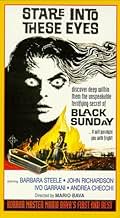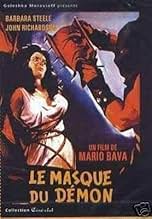AVALIAÇÃO DA IMDb
7,1/10
18 mil
SUA AVALIAÇÃO
Uma bruxa vingativa e o seu servo diabólico regressam da sepultura e iniciam uma campanha sangrenta para possuir o corpo da bela descendência da bruxa, com apenas o irmão da mulher e um belo... Ler tudoUma bruxa vingativa e o seu servo diabólico regressam da sepultura e iniciam uma campanha sangrenta para possuir o corpo da bela descendência da bruxa, com apenas o irmão da mulher e um belo médico de pé no seu caminho.Uma bruxa vingativa e o seu servo diabólico regressam da sepultura e iniciam uma campanha sangrenta para possuir o corpo da bela descendência da bruxa, com apenas o irmão da mulher e um belo médico de pé no seu caminho.
- Prêmios
- 1 vitória e 1 indicação no total
Barbara Steele
- Princess Asa Vajda
- (as Barbara Steel)
- …
Giuseppe Addobbati
- Priest
- (não creditado)
Fernando Cajati
- Crucifixion Torturer
- (não creditado)
Valentina Cortese
- Tavern Girl
- (não creditado)
Angelo Galassi
- Tavern Keeper
- (não creditado)
Nando Gazzolo
- Narrator
- (narração)
- (não creditado)
Renato Montalbano
- Spectator
- (não creditado)
Enredo
Você sabia?
- CuriosidadesMario Bava and Barbara Steele had a difficult working relationship. She sometimes refused to come to set because she did not like her wig or the fact that her cleavage would be shown. One time she refused because she believed Bava would force her to appear nude. She admits that she was difficult due to her inexperience and inability to understand Italian.
- Erros de gravaçãoIn the opening credits, Barbara Steele's name is misspelled as Barbara Steel.
- Citações
Princess Asa Vajda: You, too, can feel the joy and happiness of hating.
- Cenas durante ou pós-créditosFor "The Mask of Satan," the English language version prepared in Italy, Barbara Steele's name is listed as "Barbara Steel" on the trailer and on the credits of the film itself.
- Versões alternativasThe full list of differences between the 83-minute original cut and the 80-minute AIP cut:
- A different English-language dub, and a new score by Les Baxter.
- An added pre-text crawl warning the audience about the film's content: "The producers of the picture you are about to see feel a moral obligation to warn you that it will shock you as no other film ever has. Because it could be very harmful to young and impressionable minds, it is restricted to only those over fourteen years of age."
- Alternate opening credits.
- A brief exchange between Katja and Constantine where he tells her their father has died is cut.
- A scene where Katja and Andrej talk in the garden is cut.
- An exchange between Katja and Andrej outside her room is cut.
- Kruvajan's death scene is cut down significantly to remove shots of his eye spurting blood.
- The scene were Prince Vajda reanimates and menaces Katja is trimmed.
- Vajda's death scene, particularly the close-ups of his head melting, is trimmed.
- Asa taunting Andrej before being burned at the stake is cut.
- Added closing credits.
- ConexõesFeatured in As Motorizadas (1962)
Avaliação em destaque
A ruined abbey; Gothic interiors of a medieval crypt and castle; a matte painting of the moon illuminating the castle's exterior; a deep pit, the stonework glistening with moisture; claw-like branches against the white mist, all beautifully photographed for shadowy effect by master cinematographer Mario Bava, make this film worth watching. The thin plot involves two incestuous siblings, Asa and Javutich Vajda, executed for witchcraft in the Balkan kingdom of Moldavia, who return from the grave on Walpurgis night two centuries later to reek supernatural vengeance on their descendants.
Unfortunately the B&W beauty of this movie is compromised somewhat by Bava's awkward direction of actors whose performances range from adequate (Andrea Checci as Dr. Kruvaijan, and Ivo Garrani as Prince Vajda) to inept (Barbara Steele as both Princess Katia Vajda and Asa Vajda), to awful (John Richardson as Dr. Gorobec). The writing is likewise sub-par, and seems to borrow elements from the vintage American films "Mark of the Vampire" and "The Black Room," which Bava may have seen.
Plot holes are numerous and obvious. For instance, after draining the life from Katia's father, how does the vampire form of Dr. Kruvaijan find a ready-made coffin, and how does he bury himself? How does Katia's brother Constantine survive a fall down a deep pit to come back and destroy Javutich? The schmaltzy piano love theme is distracting, beginning immediately after Katia's first meeting with Gorobec. Nevertheless, camera poetry abounds. The slow-motion vision of the phantom coach driven by Javutich is a stunner. All of the genuinely unsettling moments are the result of Bava's uncanny use of lighting, shadow, and perspective; not the poor use of artificial-looking wax figures and lens filters to create the effects of aging on Katia's and Asa's face.
Austensibly based upon Nikolai Gogol's short story "Viy," there is only one scene in the film that is recognizable from the source material. The scene in the crypt when Krubaian is alone with, and trying to escape from the reanimated Asa, parallels the attempts of Gogol's protagonist to escape from a witch who has arisen from her coffin. Barbara Steele's makeup, the spike holes left in Asa's face by the mask of Satan, is very effective here.
Unfortunately the B&W beauty of this movie is compromised somewhat by Bava's awkward direction of actors whose performances range from adequate (Andrea Checci as Dr. Kruvaijan, and Ivo Garrani as Prince Vajda) to inept (Barbara Steele as both Princess Katia Vajda and Asa Vajda), to awful (John Richardson as Dr. Gorobec). The writing is likewise sub-par, and seems to borrow elements from the vintage American films "Mark of the Vampire" and "The Black Room," which Bava may have seen.
Plot holes are numerous and obvious. For instance, after draining the life from Katia's father, how does the vampire form of Dr. Kruvaijan find a ready-made coffin, and how does he bury himself? How does Katia's brother Constantine survive a fall down a deep pit to come back and destroy Javutich? The schmaltzy piano love theme is distracting, beginning immediately after Katia's first meeting with Gorobec. Nevertheless, camera poetry abounds. The slow-motion vision of the phantom coach driven by Javutich is a stunner. All of the genuinely unsettling moments are the result of Bava's uncanny use of lighting, shadow, and perspective; not the poor use of artificial-looking wax figures and lens filters to create the effects of aging on Katia's and Asa's face.
Austensibly based upon Nikolai Gogol's short story "Viy," there is only one scene in the film that is recognizable from the source material. The scene in the crypt when Krubaian is alone with, and trying to escape from the reanimated Asa, parallels the attempts of Gogol's protagonist to escape from a witch who has arisen from her coffin. Barbara Steele's makeup, the spike holes left in Asa's face by the mask of Satan, is very effective here.
- mhesselius
- 27 de jul. de 2010
- Link permanente
Principais escolhas
Faça login para avaliar e ver a lista de recomendações personalizadas
Detalhes
- Data de lançamento
- País de origem
- Idiomas
- Também conhecido como
- Black Sunday - A Máscara de Satã
- Locações de filme
- Empresas de produção
- Consulte mais créditos da empresa na IMDbPro
- Tempo de duração1 hora 27 minutos
- Cor
- Mixagem de som
- Proporção
- 1.66 : 1
Contribua para esta página
Sugerir uma alteração ou adicionar conteúdo ausente

Principal brecha
By what name was A Maldição do Demônio (1960) officially released in India in English?
Responda































